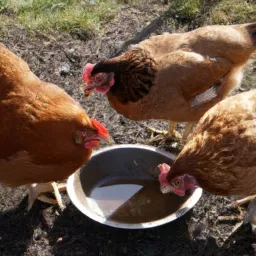Chicken Feeding 101: Understanding Your Flock’s Nutritional Needs
Feeding your chickens properly is essential to their overall health and well-being.
As a chicken owner, it’s important that you understand the nutritional needs of your flock so that you can provide them with the best possible care.
We will cover everything you need to know about feeding your chickens including consumption charts, types of chicken feed, best chicken feed options, organic chicken feed, high protein chicken feed, Purina Chicken Feed, how to store chicken feed, what happens if chicken feed gets wet, and more!
When it comes to caring for your chickens, one of the most important things you can do is make sure they are getting proper nutrition.
Chickens require a balanced diet in order to stay healthy and produce eggs or meat. It’s up to you as the chicken owner to ensure that your birds have access to fresh water and food every day.
Consumption Chart
As a general rule, chickens should be fed between 1/2 – 1% of their body weight per day depending on factors such as age, activity level, and time of year.
For example, a 5 pound bird would consume approximately 2-5 oz. of feed per day.
However, this may vary based on individual bird size and breed.
Make sure to consult with your veterinarian or local extension office for specific recommendations based on your location and climate.
Types of Chicken Feed
There are several different types of chicken feed available on the market today. Some popular choices include:
Layer ration – This type of feed is designed specifically for laying hens and contains higher levels of calcium and vitamins A and D than other feeds.
Starter feed – This feed is typically used when chicks first hatch and provides them with the necessary nutrients needed during their growth phase.
See also Xinhonglei Metal Chicken Coop Review
Grower feed – Once chicks reach a certain age, they transition onto grower feed which helps them develop into mature adults.
Maintenance feed – After your chickens stop growing, maintenance feed becomes their primary source of nutrition. This feed usually has lower protein levels than a starter or grower feed.
Best Chicken Feed
Choosing the right chicken feed can be overwhelming with all the options available on the market.
Here are some tips to help you choose the best chicken feed for your flock:
Look for feeds that contain a balance of proteins, carbohydrates, vitamins, and minerals.
Choose a brand that uses high-quality ingredients and avoids fillers like corn or wheat.
Consider purchasing locally sourced feed to support your community and reduce transportation costs.
Check with your veterinarian or local extension office for recommended brands and formulas based on your region and climate.
Nutrena Chicken Feed
Nutrena is a leading manufacturer of animal feed products including chicken feed.
They offer a variety of feed options tailored to meet the unique nutritional needs of different stages of life from chick to egg layer to broiler.
Their feeds are made with high-quality ingredients and contain optimal amounts of protein, energy, vitamins, and minerals to promote strong bones, healthy skin, and shiny feathers.
Plus, Nutrena feeds are formulated to help prevent disease and maintain optimum performance.
Organic Chicken Feed
If you prefer to use organic feed, there are several brands available on the market today.
Organic feed must meet strict guidelines set forth by the USDA regarding production practices, ingredient sources, and processing methods.
Organic feed is grown without synthetic fertilizers, pesticides, or genetically modified organisms (GMOs).
While organic feed may cost slightly more than conventional feed, many consumers feel that the benefits outweigh the additional expense.
High Protein Chicken Feed
For those looking to increase the protein content in their chicken feed, there are several options available.
See also Chicken House 58 Waterproof Wooden Animal Hutch Review
High protein feed is often used for broilers or meat birds to help them gain weight quickly.
Some popular brands of high-protein feed include:
- Harrison’s High Protein Game Bird Feed
- Hubbard Life Multi-Purpose Poultry Feed
- Showtime Broiler Feed
- Purina Chicken Feed
Purina is another well-known manufacturer of animal feed products including chicken feed.

They offer a wide range of feed options designed to meet the unique nutritional needs of different stages of life from chick to egg producer to broiler.
Purina feeds are made with high-quality ingredients and contain optimal amounts of protein, energy, vitamins, and minerals to promote strong bones, healthy skin, and shiny feathers.
Plus, Purina feeds are formulated to help prevent disease and maintain optimum performance.
How to Store Chicken Feed
It’s important to store chicken feed in a dry, cool place away from direct sunlight and moisture.
Exposure to these elements can cause the feed to become moldy or spoiled, making it unsafe for your birds to eat.
To keep your feed fresh and clean, consider using an airtight container with a tight-fitting lid.
You can also purchase specialized feed storage containers designed specifically for chicken feed.
What Happens if Chicken Feed Gets Wet?
If chicken feed gets wet, it can become moldy or spoiled, making it unsafe for your birds to eat.
Moldy or spoiled feed can lead to illness and even death in your flock. If you suspect that your feed has been exposed to moisture, throw it away immediately and replace it with fresh, dry feed.
Also make sure to store your feed in a dry, cool place away from direct sunlight and moisture to prevent future issues.
